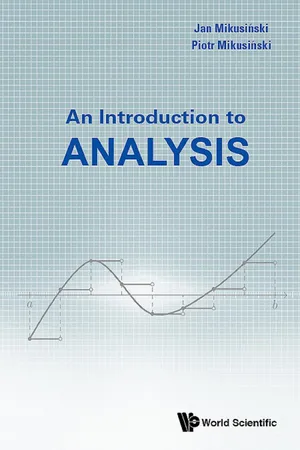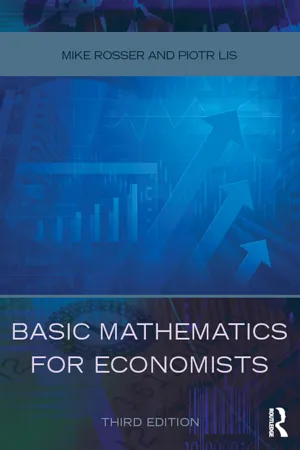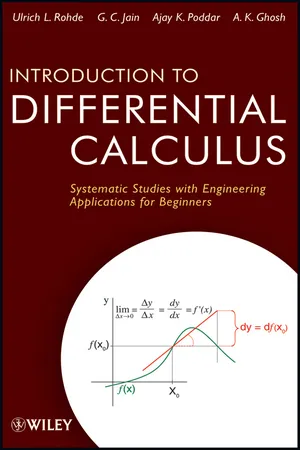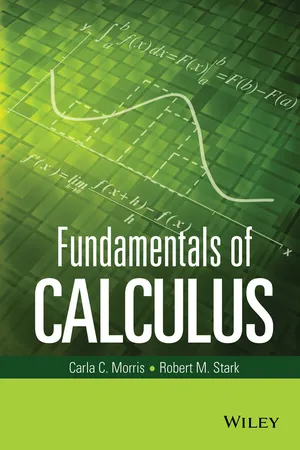Mathematics
Integrals of Exponential Functions
Integrals of exponential functions involve finding the area under the curve of an exponential function over a given interval. The process typically requires using techniques such as substitution or integration by parts to evaluate the integral. These integrals are important in various mathematical and scientific applications, including probability, growth and decay processes, and physics.
Written by Perlego with AI-assistance
Related key terms
6 Key excerpts on "Integrals of Exponential Functions"
- eBook - ePub
- Piotr Mikusi?????ski, Jan Mikusi?????ski;;;(Authors)
- 2017(Publication Date)
- WSPC(Publisher)
Chapter 7
ELEMENTARY FUNCTIONS
In this chapter we give rigorous definitions of elementary functions and establish their properties. By elementary functions we mean here exponential functions, logarithms, trigonometric and inverse trigonometric functions. In elementary calculus these functions are often considered without rigorous definitions. On the other hand, if we want to carefully define these function, we have to choose between different approaches. Our goal was to choose definitions that are natural and mathematically convenient.7.1The exponential function e
xWe now approach the didactic problem of introducing the exponential function whose value at x is ax. This function, perhaps the most important function in calculus, can be introduced in a great many ways. For instance it can be introduced as a generalization of the power anto nonnatural number values of the exponent n. First we introduce axfor negative exponents by declaring that a−n= 1/an. Next we define a1/nas the only positive solution of the equation xn= a.S:But there are values of a for which the equation has no solution, for example x2 = −1.T:Yes, and for that reason we assume that a > 0. We have to remember that the exponential function is an extension of the power with positive base.S:How do we know that a solution exists for a > 0 and that it is unique?T:This will be shown in the next section.S:And how do we define axfor other values of x?T:The exponents m/n are introduced by am/n= (a1/n)m. Finally, if x is an irrational number we approximate it by a sequence of rational numbers xn and then we prove that the sequence (ax) is convergent. The value of anxis defined as the limit of (axn).S:Since there are infinitely many sequences of rational numbers convergent to x, we may obtain infinitely many values for ax.T:No. One can prove that the limit does not depend on the choice of the sequence converging to x - eBook - ePub
- Mike Rosser, Piotr Lis(Authors)
- 2016(Publication Date)
- Routledge(Publisher)
14 Exponential functions, continuous growth and differential equations DOI: 10.4324/9781315641713-14Learning objectives
After completing this chapter students should be able to:- Use the exponential function and natural logarithms to derive the final sum, initial sum and growth rate when continuous growth takes place.
- Compare and contrast continuous and discrete growth rates.
- Set up and solve linear first-order differential equations.
- Use differential equation solutions to predict values in basic market and macroeconomic models.
- Comment on the stability of economic models where growth is continuous.
14.1 Continuous Growth and the Exponential Function
In Chapter 7 , growth was treated as a process taking place at discrete time intervals. In this chapter we shall analyse growth as a continuous process, but before we do this it is first necessary to understand the concepts of exponential functions and natural logarithms. The term ‘exponential function’ is usually used to describe the specific natural exponential function explained below. However, it can also be used to describe any function in the formaty =A xwhere A is a constant and A > 1This is known as an exponential function to base A. When x increases in value this function obviously increases in value very rapidly if A is a number significantly greater than 1. On the other hand, the value of Axapproaches zero if x takes on larger and larger negative values. For all values of A it can be deduced from the general rules for exponents (explained in Chapter 2 ) that A0 = 1 and A1 = A.Example 14.1
Find the values of y = Axwhen A is 2 and x takes the following values:- 0.5,
- 1,
- 3,
- 10,
- 0,
- −0.5,
- −1, and
- −3
Solutions
- A0.5 = 1.41
- A1 = 2
- A3 = 8
- A10 = 1024
- A0 = 1
- A−0.5 = 0.71
- A−1 = 0.50
- A−3 = 0.13
The natural exponential function
In mathematics there is a special number which yields several useful results when used as a base for an exponential function and is usually represented by the letter ‘e’. This number is - eBook - ePub
Introduction to Differential Calculus
Systematic Studies with Engineering Applications for Beginners
- Ulrich L. Rohde, G. C. Jain, Ajay K. Poddar, A. K. Ghosh(Authors)
- 2012(Publication Date)
- Wiley(Publisher)
Chapter 13a Exponential and Logarithmic Functions and Their Derivatives 13a.1 IntroductionExponential and logarithmic functions are among the most important and most practically useful functions in calculus. The definition of logarithm of any (positive) number is based on exponents and the properties of logarithms are then proved from corresponding properties of exponents.1If a > 0 (a ≠ 1), then the expression a x makes sense for any real number x . Accordingly, for any positive base a (except a = 1), the expression a x defines a sensible exponential function. In practice, a = 2, a = 10, and a = e are the most useful bases. Among all exponential functions, the one with base e (i.e., the function ex ) turns out to be especially useful and convenient. For day-to-day calculations such as those in the field of engineering, the base 10 is found to be very useful. Logarithms to the base 10 are called common logarithms . Important in calculus are logarithms to the base e called natural logarithms .(2)In many books, systematic and excellent information about the number e is available. It possesses certain unique properties valuable in many branches of mathematics, particularly calculus . For a student of mathematics, the knowledge of this unique number (and the related functions: ex , a x , ) is very essential. We give here a brief account of the number e. Its approximate value is given byFor this number, the symbol e was first adopted by the great Swiss mathematician Leonard Euler.What must you know to learn calculus? 13a-The number “e,” its origin, value, and properties Exponential and logarithmic functions (ex , loge x, ax , loga x ), their derivatives and the applications of ex (exponential growth and decay)13a.2 Origin of eThe idea of the number e comes from the practice of money lending. Consider a quantity growing in such a way that the increment of its growth, during a given time, shall always be proportional to its own magnitude. This situation resembles the process of computing interest on money lent at some fixed rate, since the bigger the capital, the bigger the amount of interest. Here, we must distinguish clearly between two ways for calculating interest on the capital: (a) at simple interest, and (b) at compound interest. - eBook - ePub
- Jay Flanz(Author)
- 2022(Publication Date)
- CRC Press(Publisher)
7 Exponentials DOI: 10.1201/9781003123880-7 7.1 e The fields of beam physics and medical physics are steeped in the properties of exponentials. It is useful to review some of the high-level properties. The exponential or Euler number (e) is given by, e = lim n → ∞ 1 + 1 n n (7.1) Or it can be represented as e = ∑ n = 0 ∞ 1 / n ! = 2.718281… The functions e x and e − x are plotted in Figure 7.1. e 1 equals the value of e = 2.718281… and 1/ e 1 = 0.3678. This 1/ e value is used frequently, as frequently as 1/10 might be used. e x is sometimes written as exp(x). The plot of e x grows and its rate of increase grows, well, exponentially. It has an interesting property in that FIGURE 7.1 Plot of e and 1/ e. d d x e x = e x (7.2) So, its derivative is equal to itself. This means that its slope at any given point is equal to its value at that point. Yes this seems trivial, but it means that if a function increases or decreases at a rate proportional to its present value, the function can be an exponential. Money might be the first thing that comes to a nonphysicists mind in this respect. Note that e 2 is just e 1 · e 1 = e 1+1. The natural logarithm ln is defined with respect to base e such that ln e x = x (7.3) The derivative is given by d d x ln x = 1 x ; d d x ln f x = 1 f (x) d (f x) d x (7.4) The exponential function e x can be expanded in a Taylor expansion, from Equation 7.1. as e x = ∑ k = 0 ∞ x k k ! = 1 + x + x 2 2 + x 3 6 + x 4 24 + ⋯ (7.5) 7.2 DISTRIBUTIONS There are many topics studied in the field of radiotherapy that are related to some sort of distribution. It could be a distribution that characterizes the survival of cells in tissue, or it could be a distribution of beam parameters in space - eBook - ePub
- Alan Jeffrey(Author)
- 2004(Publication Date)
- Chapman and Hall/CRC(Publisher)
6Exponential, logarithmic and hyperbolic functions and an introduction to complex functions
The exponential function ex was introduced in Chapter 3 as an example of a function defined by a limit. Its occurrence throughout mathematics, together with its inverse, the natural logarithmic function ln x , is sufficiently frequent to justify studying ex and ln x separately. In the first part of this chapter the differentiability property of ex is established by means of a definition of the exponential function which is different than but equivalent to the one used in Chapter 3 and makes use of that definition together with a geometrical argument and the idea that a function can be defined in terms of a series involving powers of x. The differentiability properties of the natural logarithmic function are then deduced from those of the exponential function by using the fact that dy/ dx = 1/(dx /dy).The hyperbolic functions sinhx , cosh x and tanhx are all defined in terms of the exponential function, so it is natural that they should be introduced and their differentiability properties established immediately after an account of the exponential function. The chapter then considers the exponential function with a complex argument, and shows how by making use of the series representations for the sine and cosine functions it is possible to establish de Moivre’s theorem for any real x. The theorem is then used to show how various trigonometric identities can be deduced in a simple manner. The representation of functions as series involving powers of x , called power series, is taken up again and developed formally in Chapter 12 . Finally a brief introduction to complex functions is given to justify the replacement of x by ix in the series for ex - eBook - ePub
- Carla C. Morris, Robert M. Stark(Authors)
- 2015(Publication Date)
- Wiley(Publisher)
The function increases when the base exceeds unity. The graphs of the exponential functions and illustrate these properties.. The transcendental number,, is an important base for the exponential function. The domain of is the real numbers, the range is the positive real numbers, the x -axis is an asymptote, and the y -intercept is unity. There is no x -intercept. Finally, is an increasing function as shown.. Example 4.1.3 Simplifying Exponents Involving e x Simplify the following: Solution: Removing parenthesis and multiplying the exponents yields. Subtracting exponents yields. Rewrite as. Exercises 4.1 In Exercises 1–6, rewrite the expressions with bases or. In Exercises 7–12, simplify the expressions using the laws of exponents. 7. 8. 9. 10. 11. 12. In Exercises 13–20, solve for x. 13. 14. 15. 16. 17. 18. 19. 20. In Exercises 21–25, the expressions can be factored. Find the missing factor. 21. 22. 23. 24. 25. 4.2 Logarithmic Functions Logarithmic functions are inverses of exponential functions and conversely! The relationship between logarithms and exponentials is: Logarithms and Exponentials implies and conversely Any logarithm can be expressed as an exponential and vice versa. For instance, can be expressed as. This format is convenient to determine the ordered pairs for the following graph.. While the domain for x is, the range for y is all real numbers. The x -intercept is at. There is no y -intercept. Example 4.2.1 Exponential and Logarithmic Forms Convert exponentials to logarithms or vice versa. Solution: The exponential is converted to the logarithm. The exponential is converted to the logarithm. The logarithm is converted to the exponential. The logarithm is converted to the exponential. Most calculators have two logarithmic keys: log x and ln x. The log x has a base and ln x has a base e. Base 10 logarithms are called common logarithms, while base e logarithms are called natural logarithms
Learn about this page
Index pages curate the most relevant extracts from our library of academic textbooks. They’ve been created using an in-house natural language model (NLM), each adding context and meaning to key research topics.





